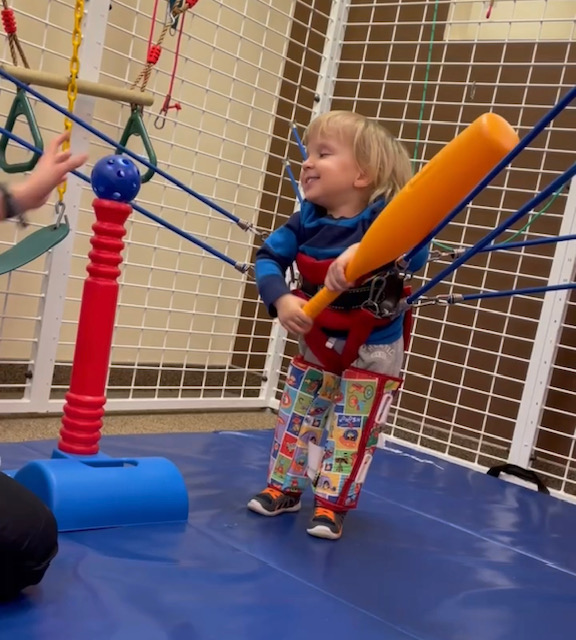

- Call 908 543 4390
- Email
- Dr.Joni Redlich PT,DPT


Trunk or core strengthening is a need for children of various diagnoses, including coordination disorders, low tone, cerebral palsy and Down syndrome. In fact most child with developmental differences regardless of diagnosis will benefit from strengthening to the trunk muscles. Read more
“My son can’t keep up with his twin.”
“My daughter is always tripping and gets frustrated.”
“We finally got answers as to why my child is delayed, but now what?”
Do these concerns sound familiar to you? Have you been worried about your child and wondering where you might find answers and help? If so, you’ve come to the right place! Let’s start by answering the question-
What is a Pediatric Physical Therapist and Who Do They Help?
Pediatric Physical therapists (PTs) are licensed health professionals who have specialized knowledge and experience in the unique aspects of working with children and their families to improve motor development, independence, fitness and active participation in the family and in the community. Pediatric PTs work with children from birth through adolescence and participate on teams with other specialists, including physicians, occupational therapists and speech therapists.
They work with children to improve their brain-body connection, balance, strength, body awareness, coordination, and movement skills from crawling and walking to jumping and hopping. Pediatric physical therapists work with children to improve their sensory awareness and motor abilities. Improvement these skills can have a far ranging impact on the child beyond the movement itself, such as improving confidence, success in school, and social interaction.

Pediatric physical therapy often looks like play, but that is part of the magic! Pediatric physical therapists know how to engage the child with fun, share the joy of movement and combine that with the science of the brain and body. All these pieces come together to stimulate to new skills that the child can use in daily life at home, at school and in the community. New skills means new confidence and new success!
Read more“I watched a remarkable, quiet, tearless session…that ended with his body and head in midline. No neck stretching!! No stretching of any kind! It’s particularly appealing in that parents get to hug and hold their children and get changes…without imposing any demands.”
Billi Cusick’s PT, MS, COF
Torticollis is a term used when a baby tends to keep their head tilted or turned to one side. The most common type of torticollis in children in Congenital Muscular Torticollis. The head is positioned in various degrees of tilt to one side and then rotation to the opposite side.Evidence-Based Care Guideline for Management of Congenital Muscular Torticollis in children age 0 to 36 months describes the traditional approach to torticollis treatment, which includes stretching, positioning, and active movement on the weaker side. The guideline does include assessing the full body, but treatment of these findings is not specifically recommended. Traditionally, the therapist will assess the full body, but then treat the neck in isolation because this is the most visible and obvious problem area.
The TMR approach to torticollis addresses the body as a WHOLE. Eliminate imbalances in the larger muscles to allow the tiny neck muscles to do their job spontaneously. Its like a potted plant growing crooked. We don’t stretch the leaves or the little stems. We repot the roots so that the plant can grow straight. Our visual and balance systems will automatically bring the head to the middle once we help balance out our roots, which in the body is the pelvis.
Some red flags that parents may notice outside of the head position or turning preference is that it may be harder to put one arm in the shirt when dressing, the baby always rolls to one side, or the baby learning to sit always falls in the same direction. Some other signs are bottom scooting rather than crawling on hands and knees, cruising along the couch in only one direction, and walking with one foot turned out.
Parents are taught how to do positioning and play at home that comfortably releases the bodies restrictions. They are also taught how to monitor their child’s movement patterns over time, so that if asymmetries increase while a child is learning a new skill, they will know how to address it.
Curious if this tearless appropach may be best for you and your baby? Call us to set up a screening at 908-543-4390.
A Dad asked me today if it was okay that his almost 2 year-old was walking on her tiptoes. His 5 year-old daughter also walks on her toes, but she has cerebral palsy, and has gone through years of botox injections and wearing orthotics to help her to stand on flat feet and to maintain the flexibility of her calves. Read more
 As promised here are some of my go-to strategies during therapy sessions. This carries over to home activities as well as any time a child is learning something new or facing a challenge. None of these strategies have anything to do with physical therapy, movement, or motor development, but without them I wouldn’t be able to guide my kiddos to reach their goals. The bottom line is that it takes two to tango and if the kiddo isn’t dancing, you’re not getting anywhere! Read more
As promised here are some of my go-to strategies during therapy sessions. This carries over to home activities as well as any time a child is learning something new or facing a challenge. None of these strategies have anything to do with physical therapy, movement, or motor development, but without them I wouldn’t be able to guide my kiddos to reach their goals. The bottom line is that it takes two to tango and if the kiddo isn’t dancing, you’re not getting anywhere! Read more
Today was a great reminder as to how far a little laughter can take you when working with a child to overcome a challenge. I was at the park with a little girl I treat in the early intervention program. She is almost 2 and had never been on a playground swing. She has unique medical needs that have limited her exposure to a lot of things outside her home, but today we were at the park and ready to give the swing a shot. She didn’t complain at all getting in. She has seen her older brother and sister on swings, so she definitely had the message that this was going to be FUN. Her mom put her in and started pushing her. Read more
Children toe-walk for various different reasons. Medical causes such as cerebral palsy and muscular dystrophy must be ruled out. Many children on the autism spectrum will also toe-walk. Additionally, children without any other diagnoses have been called idiopathic toe walkers. It is important to understand that toe-walking is a MOVEMENT problem, not just an ANKLE problem. This is why toe-walking can be challenging to parents and therapists alike. A whole body approach is needed to achieve great results! Read more
I just came from the house of an adorable 10 month old girl who I see through early intervention. She has been an amazing example of how quickly a child with an intact neurological system can learn new skills. This little girl had a rough start medically, but is now very healthy. With the medical concerns stabilized, her family was very concerned about her from a developmental perspective. When I started with her a couple of months ago she was barely sitting. Today she was crawling, cruising, and pulling to stand beautifully! She is now doing what other children her age are doing and is taking off. Read more
I saw 2 kids today who are similar in their motor skills. They both have cerebral palsy and walk independently with their walkers. They are both verbal, sweet as can be, beautiful, fun, smart kiddos. They are very different though in their independence in their daily lives. The boy has been pushed to be as independent as possible from early on. He was allowed to fall and learned how to be responsible for his own body in space. The girl was never allowed to fall and has learned very well how to get her family and nanny to do things for her. Read more
 The following is an essay that a mom of one of my soon-to-be-discharged early intervention kiddos wrote for a contest through the NJ Early Intervention program. Not only did she win the contest (yay!), but it conveys to parents the hope that early intervention can bring to a family and the difference that therapy early on can make in a child’s life.
The following is an essay that a mom of one of my soon-to-be-discharged early intervention kiddos wrote for a contest through the NJ Early Intervention program. Not only did she win the contest (yay!), but it conveys to parents the hope that early intervention can bring to a family and the difference that therapy early on can make in a child’s life.
If I had to sum up in one word what The NJ Early Intervention System has meant to our family, its hope. When our youngest son Jonathan was born prematurely and soon after found to have hypotonia and both fine and gross motor delays we were so worried. What did this mean for his future? Would he ever catch up? What could we do to help him? So many concerns ran through our minds initially and then as we began our relationship with the early intervention program we began to find some answers and more importantly we began to find some hope. Read more
